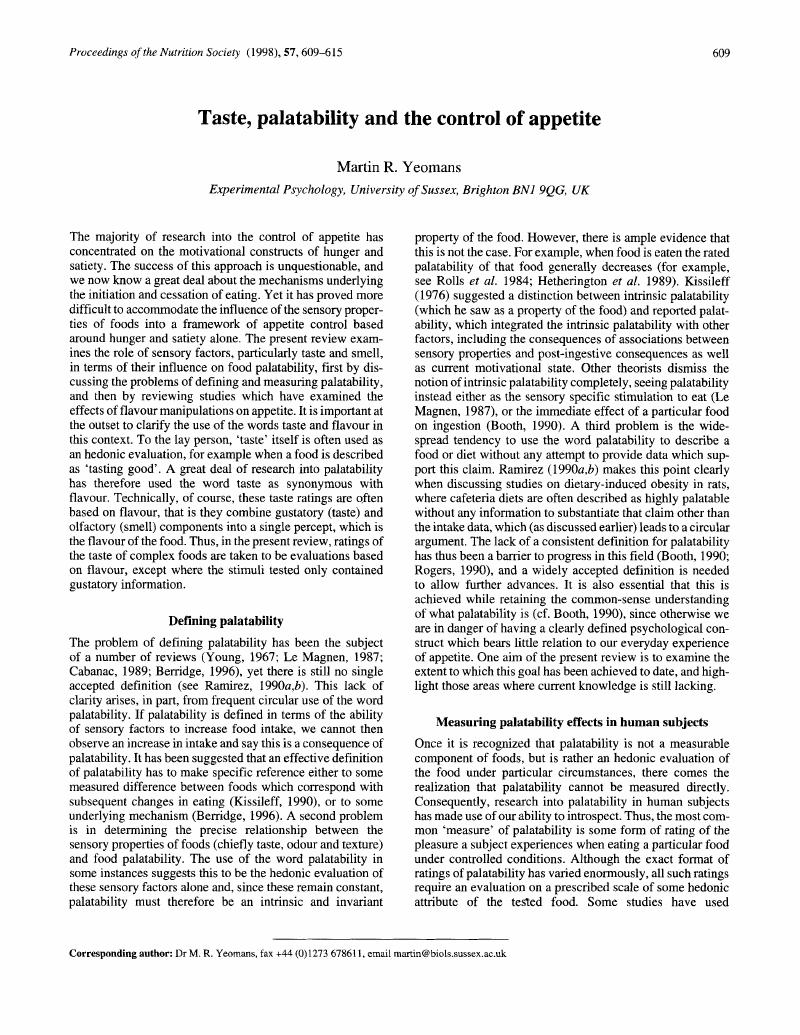Crossref Citations
This article has been cited by the following publications. This list is generated based on data provided by Crossref.
Passe, D.H.
Horn, M.
and
Murray, R.
2000.
Impact of beverage acceptability on fluid intake during exercise.
Appetite,
Vol. 35,
Issue. 3,
p.
219.
Yeomans, MR
Lee, MD
Gray, RW
and
French, SJ
2001.
Effects of test-meal palatability on compensatory eating following disguised fat and carbohydrate preloads.
International Journal of Obesity,
Vol. 25,
Issue. 8,
p.
1215.
French, Stephen J.
and
Yeomans, Martin R.
2001.
Role of the upper gastrointestinal tract in regulation of human feeding.
Nutrition,
Vol. 17,
Issue. 3,
p.
264.
French, Stephen J.
and
Cecil, Joanne E.
2001.
Oral, gastric and intestinal influences on human feeding.
Physiology & Behavior,
Vol. 74,
Issue. 4-5,
p.
729.
Morley, J. E.
2001.
Decreased Food Intake With Aging.
The Journals of Gerontology Series A: Biological Sciences and Medical Sciences,
Vol. 56,
Issue. Supplement 2,
p.
81.
Nasser, J.
2001.
Taste, food intake and obesity.
Obesity Reviews,
Vol. 2,
Issue. 4,
p.
213.
Carstens, E
Iodi Carstens, Mirela
Dessirier, Jean-Marc
O'Mahony, Michael
Simons, Christopher T
Sudo, Makoto
and
Sudo, Satoko
2002.
It hurts so good: oral irritation by spices and carbonated drinks and the underlying neural mechanisms.
Food Quality and Preference,
Vol. 13,
Issue. 7-8,
p.
431.
Yeomans, M.R.
and
Phillips, M.F.
2002.
Failure to Reduce Short-term Appetite Following Alcohol is Independent of Beliefs about the Presence of Alcohol.
Nutritional Neuroscience,
Vol. 5,
Issue. 2,
p.
131.
French, Stephen
and
Castiglione, Kate
2002.
Recent advances in the physiology of eating.
Proceedings of the Nutrition Society,
Vol. 61,
Issue. 4,
p.
489.
Sørensen, L B
Møller, P
Flint, A
Martens, M
and
Raben, A
2003.
Effect of sensory perception of foods on appetite and food intake: a review of studies on humans.
International Journal of Obesity,
Vol. 27,
Issue. 10,
p.
1152.
Yeomans, Martin R.
Blundell, John E.
and
Leshem, Micah
2004.
Palatability: response to nutritional need or need-free stimulation of appetite?.
British Journal of Nutrition,
Vol. 92,
Issue. S1,
p.
S3.
Yeomans, M R
Tovey, H M
Tinley, E M
and
Haynes, C J
2004.
Effects of manipulated palatability on appetite depend on restraint and disinhibition scores from the Three-Factor Eating Questionnaire.
International Journal of Obesity,
Vol. 28,
Issue. 1,
p.
144.
Whybrow, S.
Mazlan, N.
and
Stubbs, R.J.
2005.
Food, Diet and Obesity.
p.
179.
Whybrow, S.
Mazlan, N.
and
Stubbs, R.J.
2005.
Food, Diet and Obesity.
p.
179.
Mela, David J.
2006.
Eating for pleasure or just wanting to eat? Reconsidering sensory hedonic responses as a driver of obesity.
Appetite,
Vol. 47,
Issue. 1,
p.
10.
Yeomans, Martin R.
2007.
Appetite and Body Weight.
p.
247.
Finlayson, Graham
King, Neil
and
Blundell, John E.
2007.
Liking vs. wanting food: Importance for human appetite control and weight regulation.
Neuroscience & Biobehavioral Reviews,
Vol. 31,
Issue. 7,
p.
987.
Mela, D.J.
2007.
Understanding Consumers of Food Products.
p.
393.
Papies, Esther K.
Stroebe, Wolfgang
and
Aarts, Henk
2008.
Understanding dieting: A social cognitive analysis of hedonic processes in self-regulation.
European Review of Social Psychology,
Vol. 19,
Issue. 1,
p.
339.
Benelam, B.
2009.
Satiation, satiety and their effects on eating behaviour.
Nutrition Bulletin,
Vol. 34,
Issue. 2,
p.
126.



